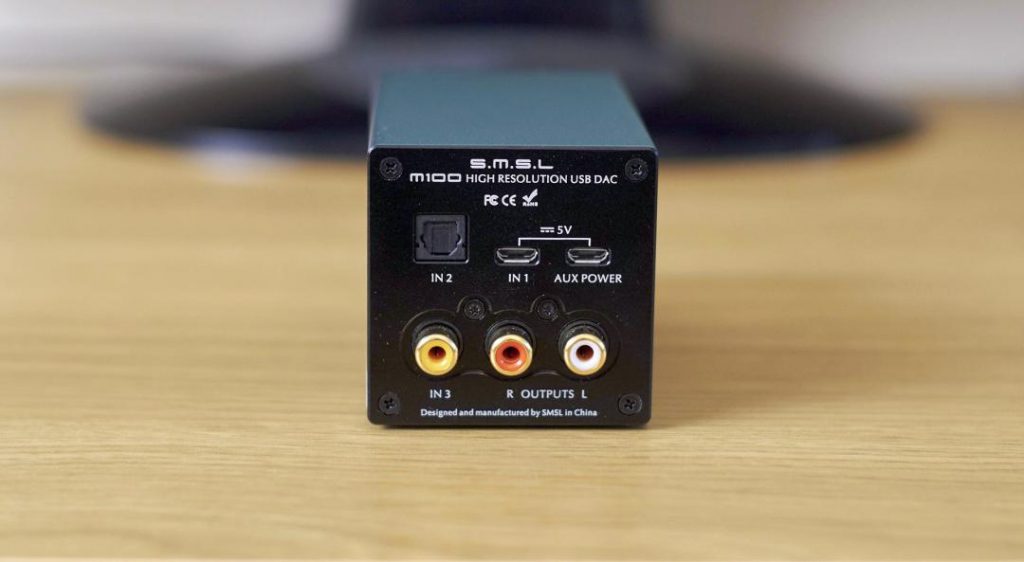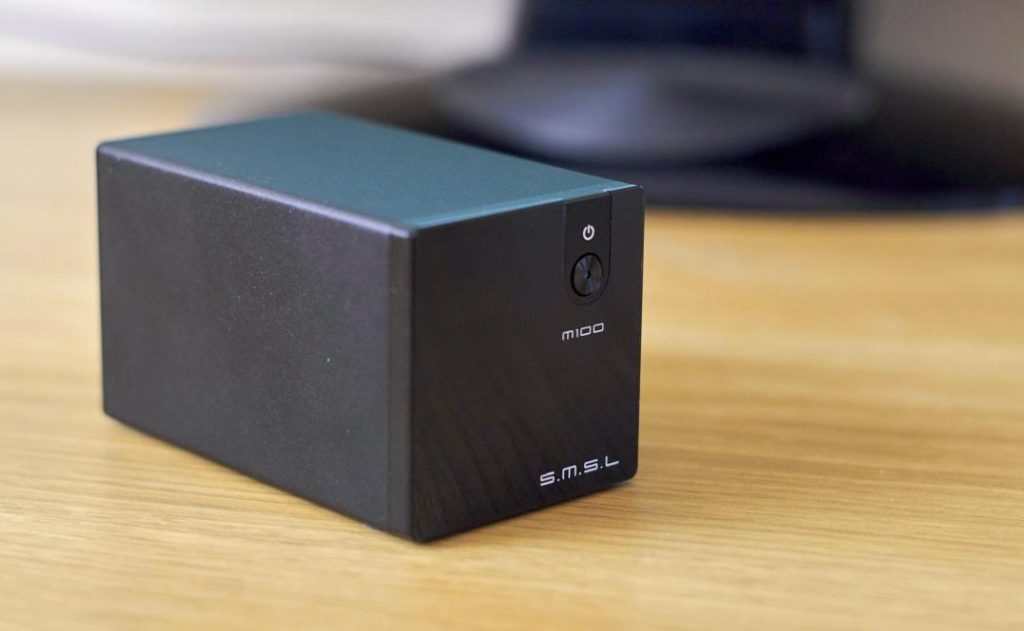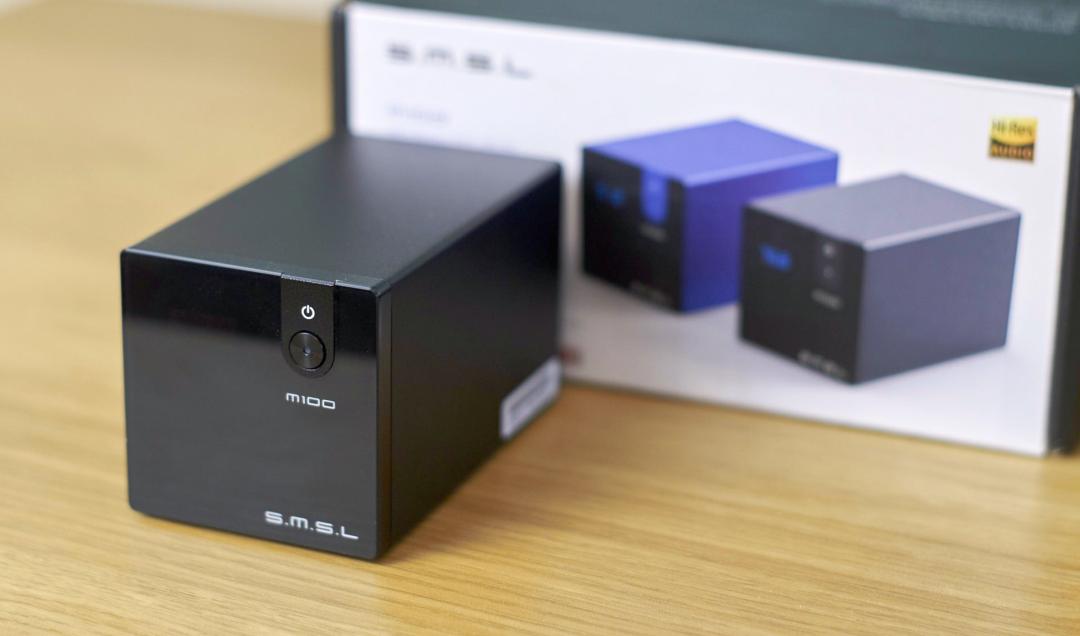SMSL has presented us with yet another small and affordable DAC – M100. Let’s see what it has to offer and how it compares to the competition.
BUILD AND DESIGN
First of all, let’s talk about its design and build. The unit is very small, even smaller than it’s usual for DACs nowadays, but doesn’t feel cheap in any way. It’s actually finished quite nicely, it’s reasonably heavy and for some reason, it just feels nicer and sturdier in my hands than Sanskrit 10th. It is like the more dense and compact version of it – which I like. This time SMSL is producing a black version too, which is great because it’s black, and black is evergreen.

Not lacking in connections
On the back, we have two USB inputs – one for both audio signal and power, and the other one exclusively for external power supply. You don’t need to use it – but my experience with Sanskrit 10th proved auxiliary power to be important for achieving the best possible audio quality. Is it the same case with M100 – we’ll get to it a bit later. Other then USB ports there’s a typical set of digital inputs: coaxial and optical. Regarding outputs, we find only one pair of gelded RCAs for a line-out. For such a small unit it’s very nice they didn’t skimp on digital connections, you may not need them but it’s always good to have options.
On the front, we find just one button and a small screen. You turn it on and off by holding the button and change inputs by pressing it shortly. That’s all – there’s no volume control, you can’t choose different filters or anything like that. Now, if it does its job properly and sounds good, just a good old pure D/A converter is enough for me.

M100 has a monolithic design
SOUND
So let’s get to it and find out how does it sound. My first impression was it sounds quite detailed and open, or on the bright side if you will. In terms of frequencies, we get nice and tidy bass lines. Bass on M100 is not as warm and soft as on Sanskrit 10th, but I never felt that I’m missing any bass weight either. It’s simply not warm and fluffy – it is neat and precise instead. Going to midrange, you get plenty of details in voices and sharp leading edges. Slightly prominent highs are adding spark to these edges creating clear and precise sound overall, rich with tiny little details all over the soundstage.
Bundle all of that together and it makes for a nice and open sound with plenty of details. It is on the analytical side of things though. M100 certainly puts details and clarity over warmth and fluidity. If your system sound needs some spark, it needs to open up a little, this might be a good thing. On the other hand, if you already have open and revealing devices elsewhere, this may tip the whole balance over the edge and make it sound too analytical and sharp. Unlike my experience with Sanskrit 10th, I didn’t hear any meaningful difference adding auxiliary power to M100. While Sanskrit 10th really does sound better that way – M100 doesn’t seem to need it to sound its best.
COMPETITION
Compared to other DACs I’ve listened so far this little thing can definitely hold its ground. It’s slightly more open and detailed than a bit cheaper FX-Audio DAC X6. It’s definitely more precise sounding than DragonFly Black. Compared to slightly more expensive Sanskrit 10th it is as open and detailed, but while you had warm and cozy bass there, the one on M100 is tight and precise. Asked to choose which one is better, I’m not sure I could do that – they’re just a bit different. If you want your sound to favor fullness and fluidity over every last tiny detail feel free to go with Khadas Tone Board – it will place more meet on your musical bones at the expense of some high-frequency clarity. If you can stretch your budget a little bit, Schiit Modi 3 is an option worth considering. It can deliver the same amount of details and clarity but with some added midrange thickness.
CONCLUSION
To sum it up – M100 offers quite precise and analytical sound. If you like that kind of signature and you don’t need a headphone output, remote or volume control this can be a very nice purchase. Honestly, at such a low price it would be rude to ask for anything more.
| SMSL M100 – CHARACTERISTICS |
| D/A converter: Asahi Kasei Microdevices AK4452 Supported formats: PCM up to 768 kHz, up to DSD512 Digital inputs: 1 x USB, 1 x Coax, 1 x Optical Analog outputs: 1 x RCA Dynamic range: 114 dB THD: < 0.0005 % Dimensions: 55 x 55 x 93 mm Weight: 258 g Price at time of testing: $70 |






Do you plan to do a review on SMSL M300 MKII? SMSL have very few review available but seem to have a good reputation but most of the SMSL devices reviewed seem to indicate that it is lacking on the bottom and highs. I am considering SMSL, Topping D50S or a Schiit modi 3.
I’m thinking about it… Looks interesting. But it’s hard to import anything currently into my country. We don’t receive international packages yet due to this whole Corona crisis. I hope things will get back to normal soon.
Dragi Srboljube,
slažem se s Vama. Mali M100 stoji kod mene pored 15000 Eur Ayon Stratos + NWT, i mogu Vam reći da je najveća razlika u visokima. Ayoni daju više vazduha i malo veću rezoluciju ako se sluša preko eletrostatskih slušalica preko SE cevaša.
pozdrav
Rudi